Author: Marshall Schott
Homebrewing is a hobby that most enjoy spending time doing, and hence a 4-6 hour brew day can be viewed as a great way to kill some time doing what one loves. Unfortunately, some of us have other things going on that limit the amount of time we’re able to spend engaging in an activity by ourselves, so any time we can cut out of brewing is good and can even allow us do it more often. With a full-time job, a couple side gigs I manage, a family with 3 kids, and friends who like to have fun all the time, committing an entire morning to making beer can sometimes feel like a sacrifice. But what if I could get away with making a batch of delicious beer in half the time or even less?
Over the last couple years, we’ve made a few different styles of beer using Short & Shoddy methods consisting of a significantly abbreviated mash and boil, the two biggest time-sinks in brewing. To the surprise of many, the beers we’ve made including lagers and NEIPA have all come out far better than expected, to the point blind tasters were unable to tell they were brewed in such a manner. Continuing on our quest to see how Short & Shoddy methods impact various styles, I designed a Porter recipe featuring Gladfield Malt’s Light Chocolate malt I brought home from my recent trip to New Zealand.
Short & Shoddy Oatmeal Porter
Recipe Details
| Batch Size | Boil Time | IBU | SRM | Est. OG | Est. FG | ABV |
|---|---|---|---|---|---|---|
| 5.5 gal | 20 min | 34.5 IBUs | 32.6 SRM | 1.052 | 1.014 | 5.0 % |
| Actuals | 1.052 | 1.01 | 5.5 % | |||
Fermentables
| Name | Amount | % |
|---|---|---|
| Pale Malt (2 Row), Rahr | 10 lbs | 71.43 |
| Oats, Flaked | 2 lbs | 14.29 |
| Caramel/Crystal Malt - 60L | 1 lbs | 7.14 |
| Gladfield Light Chocolate Malt | 1 lbs | 7.14 |
Hops
| Name | Amount | Time | Use | Form | Alpha % |
|---|---|---|---|---|---|
| Magnum | 50 g | 20 min | First Wort | Pellet | 11.2 |
| Hallertauer Mittelfrueh | 30 g | 15 min | Boil | Pellet | 2.4 |
| Hallertauer Mittelfrueh | 30 g | 5 min | Boil | Pellet | 2.4 |
Yeast
| Name | Lab | Attenuation | Temperature |
|---|---|---|---|
| Pub (A09) | Imperial | 72% | 64°F - 70°F |
Notes
| Water Profile: Black Balanced in Bru’n Water Spreadsheet |
Download
| Download this recipe's BeerXML file |
As is true with most of my Short & Shoddy brew days, this one wasn’t totally planned out in advance. I’d prepared for a typical xBmt brew day a few days ahead of time by designing a recipe and preparing a starter of Imperial Organic A09 Pub Ale yeast, but life happened and forced me to rethink my weekend schedule.
Instead of my planned Saturday brew, I ended up carving out some time Sunday morning and decided to see how quickly I could make an Oatmeal Porter, inviting my friends Jersey and Tim over for a lesson in potentially disastrous brewing. We started at 10:50 AM by filtering the full volume of brewing liquor.
While the water was filling my kettle, I weighed out the grains, using a nice dose of Light Chocolate malt from New Zealand’s Gladfield Malt.
With the appropriate volume of water collected, I hit the flame on my burner to heat the water to the strike temperature given by BeerSmith.
Tim brought over a pitcher of his wife’s awesome Bloody Mary and poured me a glass, a tasty morning treat while I ran the grains through the mill directly into the BIAB fabric filter.
Strike temperature was reached at 11:15 AM and Jersey dropped the bag of grains directly into the kettle of hot water, stirring for about 3 minutes to ensure any dough balls were busted up.
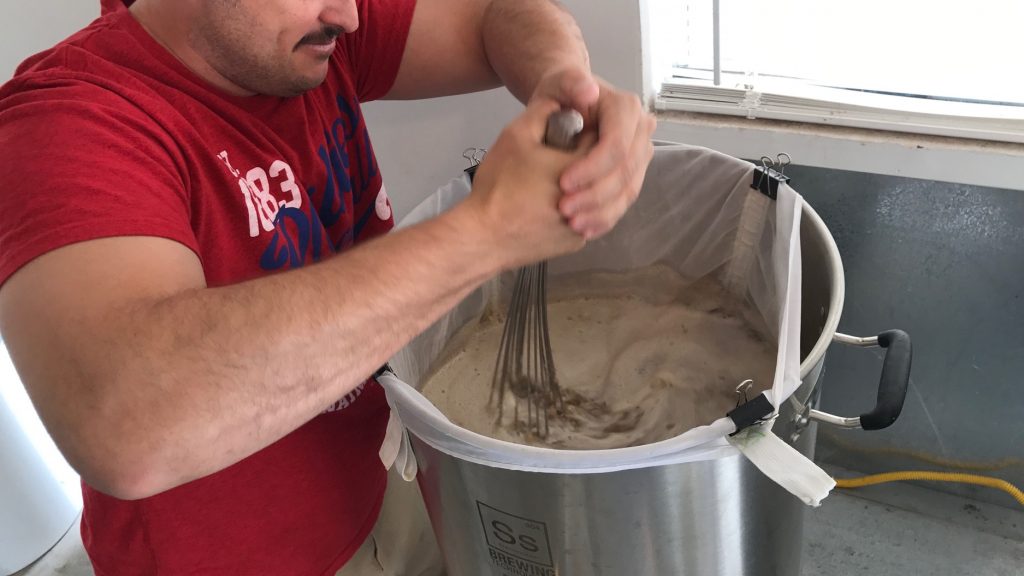
For rarely using the traditional Brew In A Bag method, I was pleased with how close the mash temperature was to my 152°F/67°C target.
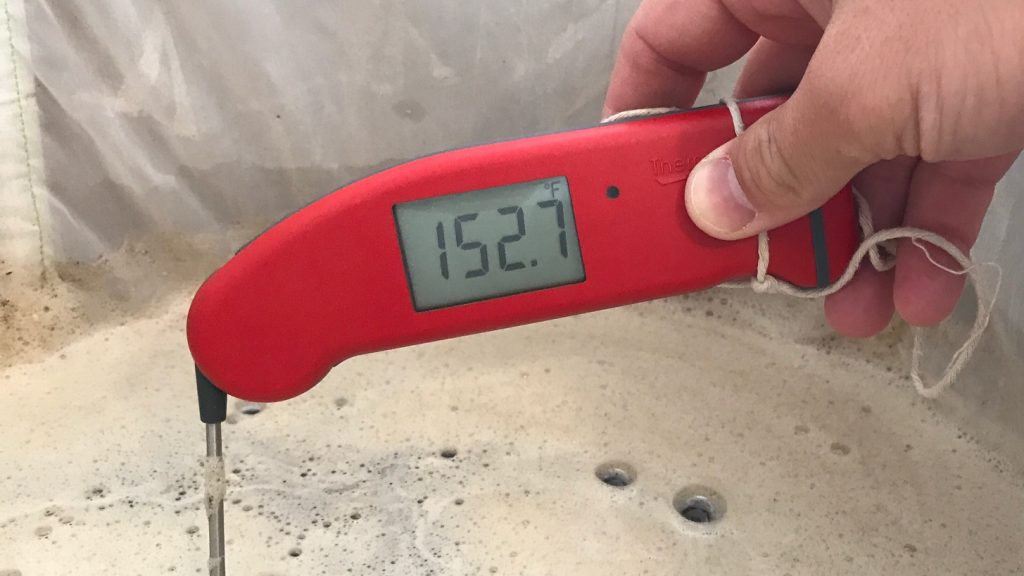
I set a timer for 20 minutes, covered the mash to retain as much heat as possible, and asked Jersey to manage occasional stirring throughout the rest. A pH sample taken 10 minutes into the mash showed we were right on target.
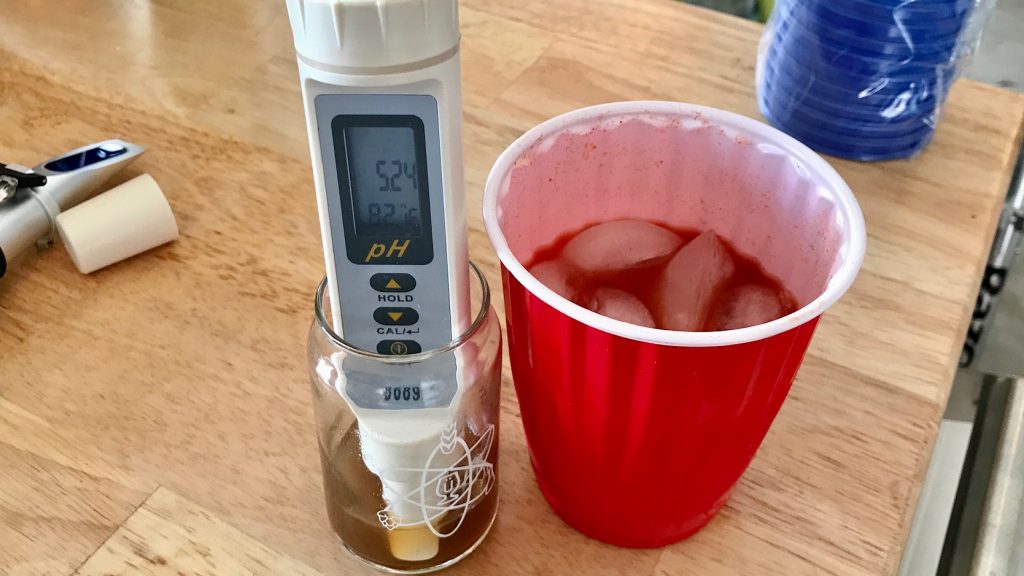
As soon as the timer went off, I removed the grains, squeezing the bag only enough to reach my target pre-boil volume, then lit the flame on my burner. I threw my immersion chiller into the wort at this point given the abbreviated boil I had planned.
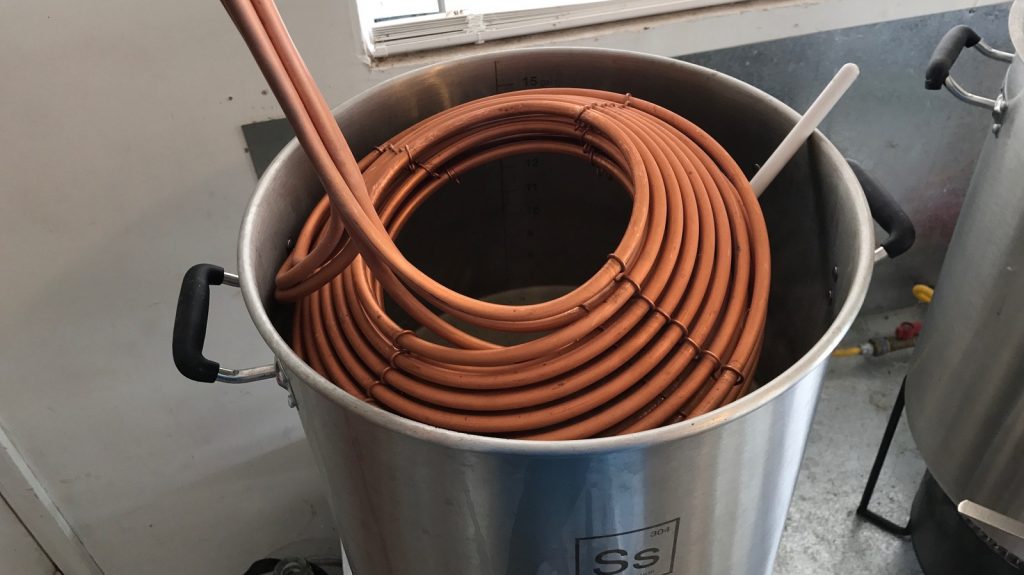
It took about 18 minutes for the wort to start boiling, at which point I again set my timer for a mere 20 minutes and left the task of adding hops to the boiling wort to my neighbors.
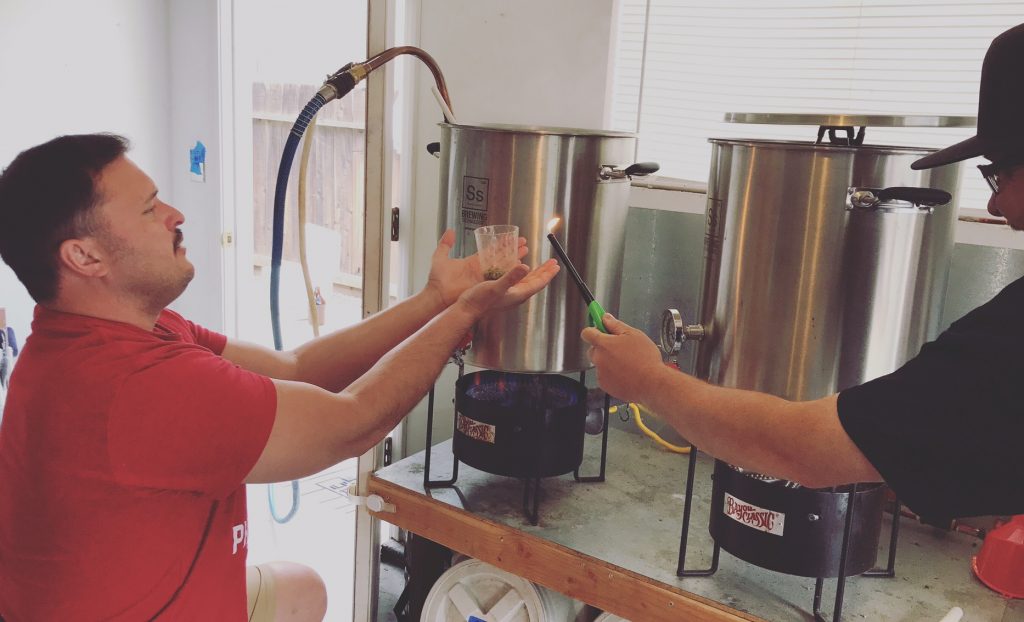
At 12:05 PM, the boil was complete and I proceeded to quickly chill it to just above my annoyingly warm groundwater temperature this time of year, it took just under 10 minutes. I then transferred 5.5 gallons/21 liters of the 80°F/27°C wort to a sanitized Brew Bucket.
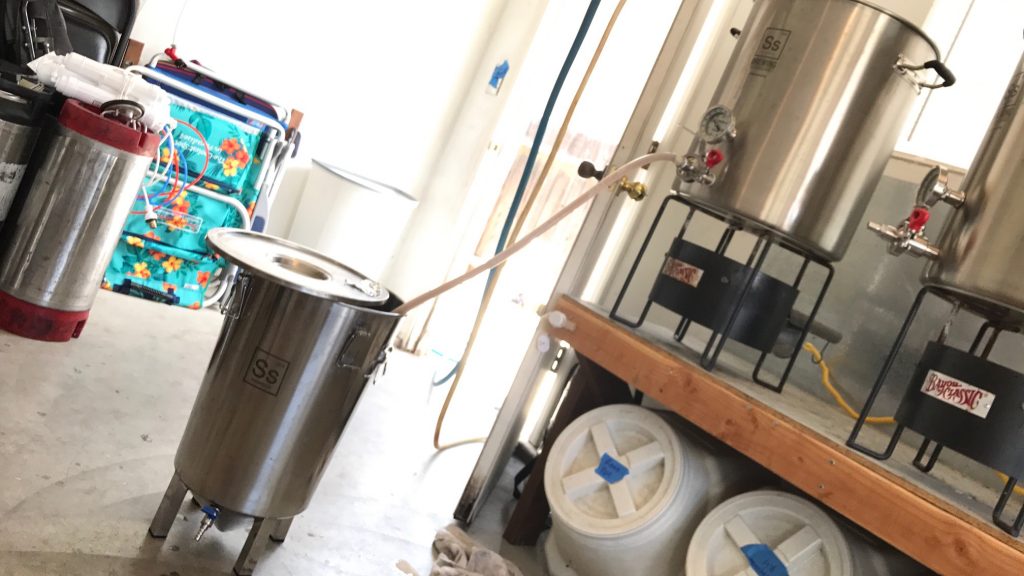
A refractometer reading showed my efficiency prediction of 57% based on prior short & shoddy batches was solid, as the wort was sitting right at the 1.052 OG I was aiming for.
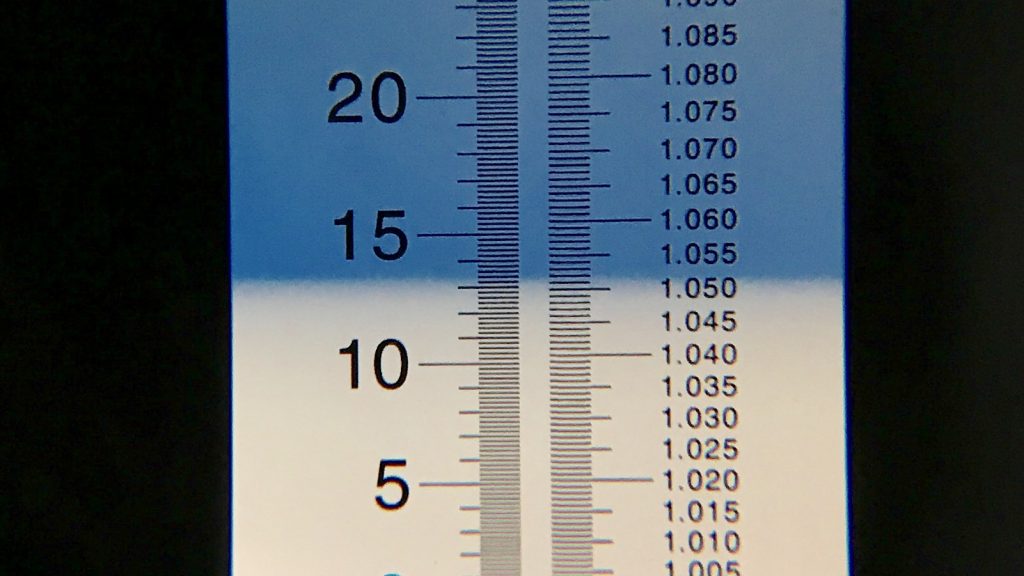
I set the Brew Bucket in my chamber controlled to 66°F/19°C and, rather than wait for the wort to chill like I normally do, pitched the yeast starter, supernatant and all (after harvesting a liter for future use first). The time immediately after pitching the yeast was 12:31 PM, just 1 hour and 41 minutes after my brew day began. Jersey and Tim helped me clean some things up then we drank a couple beers before sitting down to record a couple 1 minute beer reviews for The Brülosophy Podcast.
The beer was left to ferment while Jersey, a bunch of other rad homebrewers, and I attended Homebrew Con 2017. I took an initial hydrometer measurement 8 days after the beer was brewed that showed it had like reached FG. I let it sit 2 more days out of laziness before checking again, it was the same.
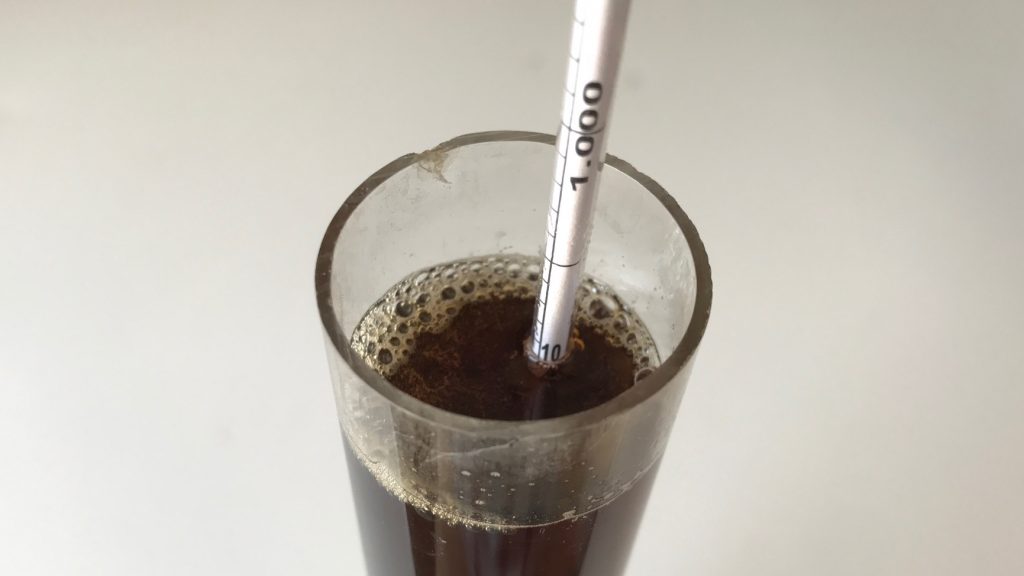
I cold crashed the beer to 32°F/0°C for 22 hours, skipping the gelatin fining step given the highly flocculant nature of Imperial Organic A09 yeast, then kegged and burst carbonated it at 55 psi for 15 hours before reducing the gas to serving pressure. I started drinking and sharing the beer with unsuspecting tasters a couple days later when it was carbonated and clear.
| IMPRESSIONS |
It’s been awhile since I made a Porter, and I’ve never made one with oatmeal using short & shoddy methods. When designing this recipe, I was aiming for something velvety smooth with a noticeable chocolate character balanced by a whisper of roast, precisely what I perceived when sampling Gladfield Malt’s Light Chocolate malt in blind trials. I’d run out of Fuggles, the hop variety I typically reach for when making styles like this, so I relied instead on the noble Hallertau Mittelfrüh in hopes of imparting a touch of earthy and spice character. While I’d never used Imperial Organic A09 Pub Ale yeast, I’d heard it was sourced from same place as other labs’ English ale yeasts, strains I’d come to depend on to produce beautiful dark ales.
Of course, the beer was designed for an xBmt in which mostly conventional methods would have been used. However, given the short & shoddy nature of this brew day, it might be presumed the finished beer would be thin and watery due to low ABV as a result of the poor efficiency of a 20 minute mash, reek of cooked corn or cabbage from the DMS present because of a 20 minute boil, and taste of wicked esters and fusel alcohols caused by the yeast being pitched into 80°F/27°C wort. There was a lot that could go wrong with this batch, no doubt.
Something certainly was wrong with this Oatmeal Porter– it was so damn good I couldn’t keep my hands off of it! Super creamy mouthfeel, beautifully balanced chocolate and roast character with a solid toasty note in the finish, just bitter enough to keep the malt character from becoming overwhelming, and I personally couldn’t find any fermentation flaws. This Oatmeal Porter was not only one of the best I’ve ever made, but I enjoyed drinking it more than I do many of my favorite commercial examples of the style.
What Did Others Think?
It’s entirely likely my perception of this Short & Shoddy Oatmeal Porter as being so tasty was influenced by bias, so I shared it with friends who had no clue how it was made in hopes of gleaning more impartial reviews. Presenting beers to tasters in a way that doesn’t scream “evaluate this!” can be difficult, and since I want to have as little influence as possible, I always try to play coy by simply serving the beer without preface then asking for feedback while we’re drinking.
I served this beer to quite a few people but only took notes for 9 of them including a professional brewer, BJCP judges of varying rank, experienced homebrewers, and a couple friends who tend to stick only to beers that many scoff at. One thing I’m absolutely certain of is that not a single person I served the beer to said anything glaringly negative, and my notes from the 9 tasters I paid closer attention to are also absent of any comments about off-flavors. Rather, descriptors used prior to me informing them of the short & shoddy methods used to make the beer included chocolate, smooth, delicious, not too roasty, very nice, and better than real beer you should start your own brewery. So far, so good, I mostly agree. Then I told them what was up.
Similar to past short & shoddy beers we’ve written about, the people who possessed some understanding of brewing processes were visibly and audibly floored when I revealed the beer had been made with a 20 minute mash, 20 minute boil, and was pitched at 80°F/27°. Of course, a few people asked for an extra sample so that they could attempt to look more closely for expected flaws, none of them noted any on second pass, and others asked for another sample just to enjoy.
| CONCLUSION |
On a recent Facebook post of an xBmt showing no distinguishable difference between cool and warm fermented lagers, a person commented something along the lines of, “then where is all the shitty beer coming from?” I can absolutely relate with this sentiment, in fact as recently as about 3 years ago I would have agreed that most shitty beer is the result of skipping important steps, or “cutting corners” as the commenter put it. However, based on the results of numerous xBmts focused on such steps as well as a bunch of anecdotal experiences, I’m willing to admit I no longer share this perspective and view it as being quite erroneous.
In past short & shoddy articles, we’ve mentioned that while such methods can make a fine beer, more conventional approaches should be used for those looking to win awards. I can’t speak for the others, but looking back, I’m pretty sure I was just playing it safe, as this Oatmeal Porter and other short & shoddy beers I’ve tasted were fantastic with none of the flaws we’ve been taught to expect, even if they are perceptibly different than beers made using conventional methods. Admittedly, this change of heart was also motivated by the numerous brewers I’ve heard from who are taking home competition medals with beers made using abbreviated techniques. Either way, I was stoked with this beer and look forward to using both Imperial Organic A09 yeast and Gladfield Malt grains more often in my brewing.
We’ve gone over possible reasons good beer doesn’t require conventional methods in the past, stuff like modification of modern malts, overall improvements in yeast quality, and a generally better understanding of the brewing process, so I won’t harp on that here. Instead, I’m going to do something I rarely do and encourage people who might be pressed for time to give short & shoddy brewing a shot! With good sanitation practices and accounting for poorer efficiency, I fully trust most will be just as surprised as I’ve been with the final results, and it may even allow you to squeeze a few more brew days into your life.
If you have thoughts about or experience with Short & Shoddy brewing, please share them in the comments section below!
Support Brülosophy In Style!
All designs are available in various colors and sizes on Amazon!
Follow Brülosophy on:
FACEBOOK | TWITTER | INSTAGRAM
If you enjoy this stuff and feel compelled to support Brulosophy.com, please check out the Support Us page for details on how you can very easily do so. Thanks!

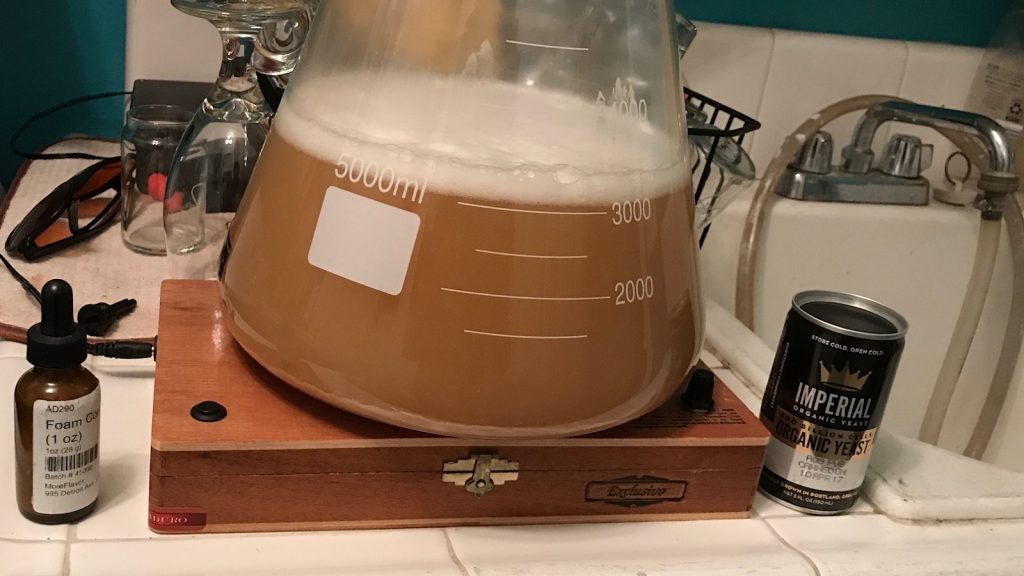
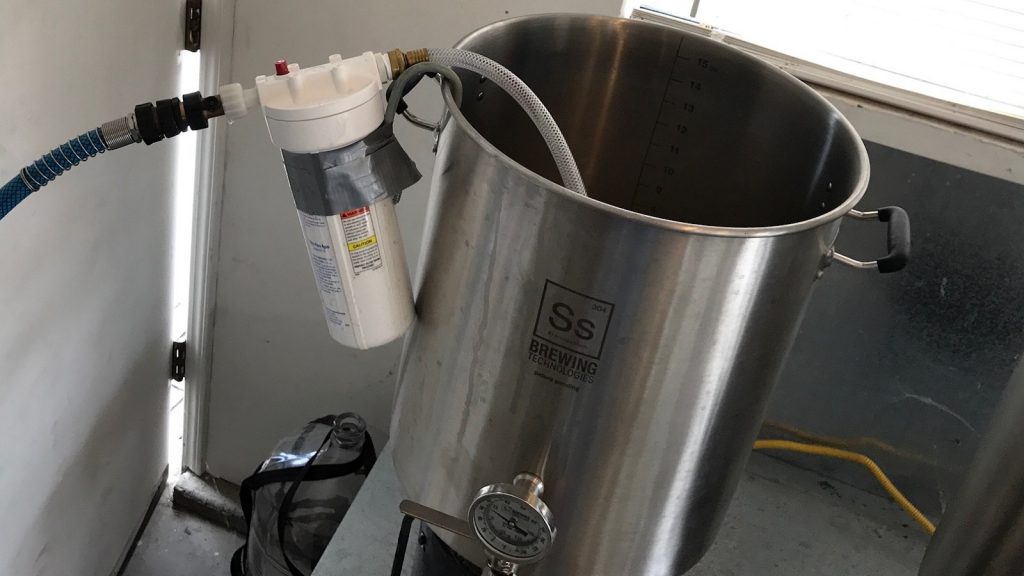
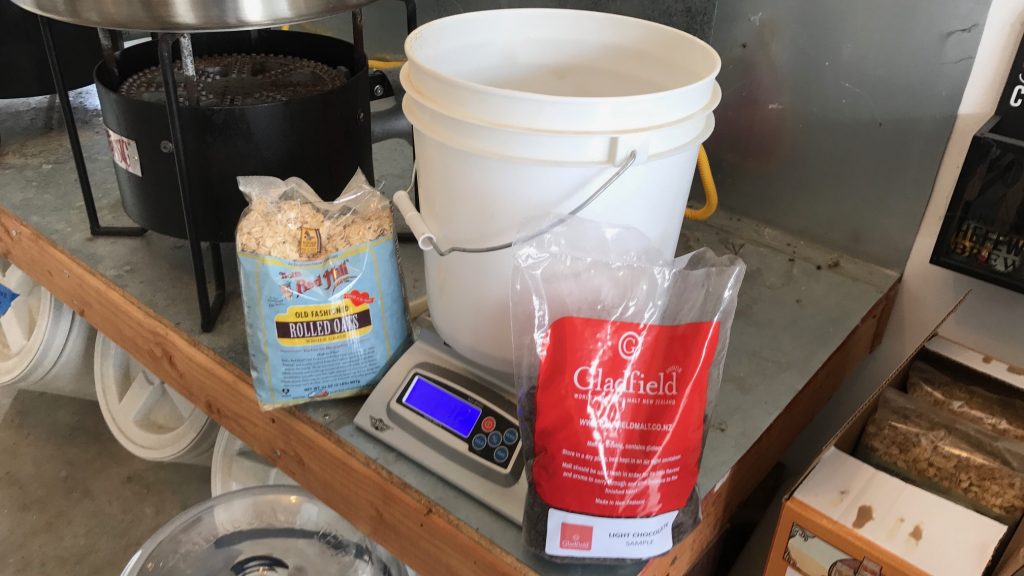
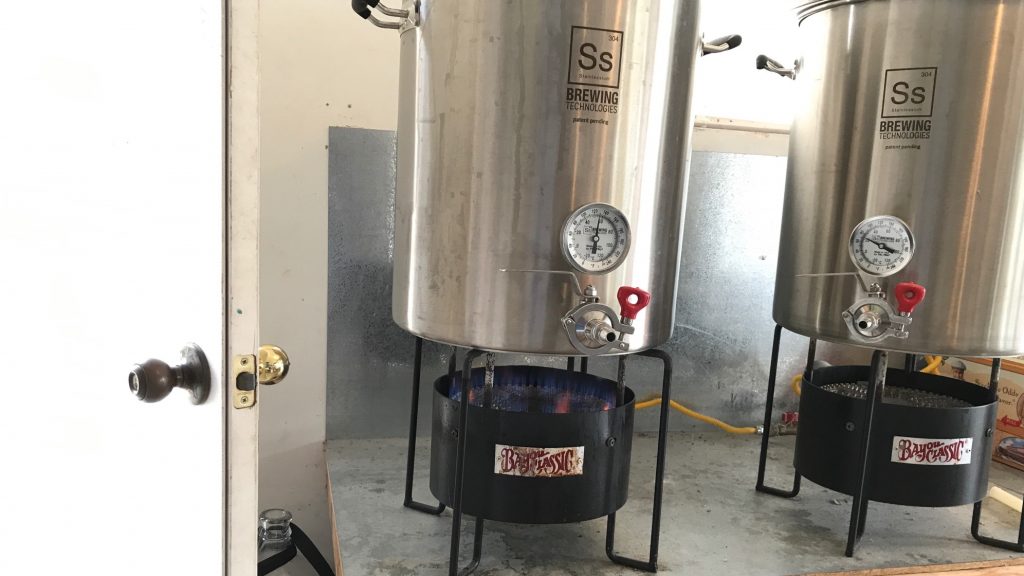
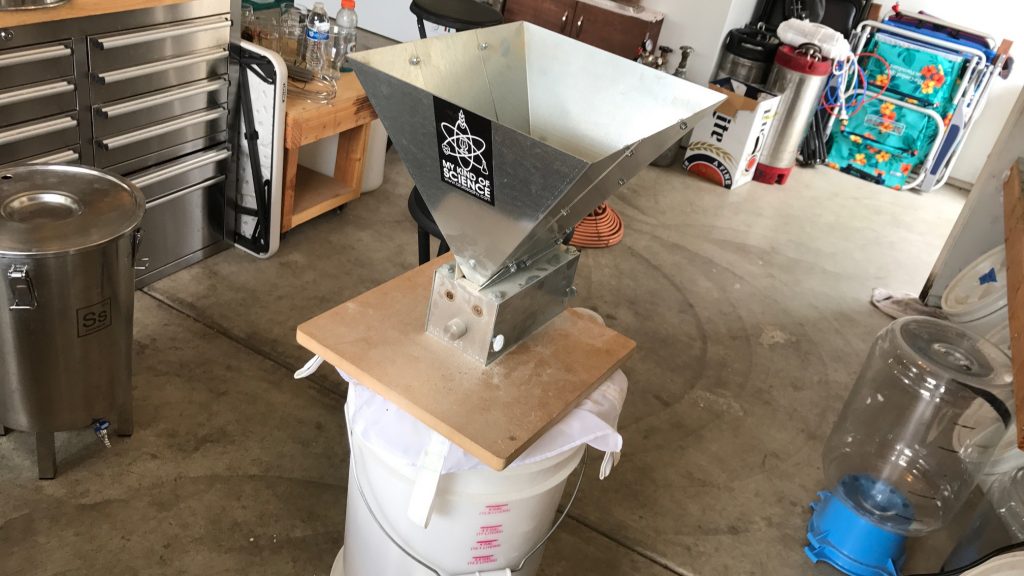

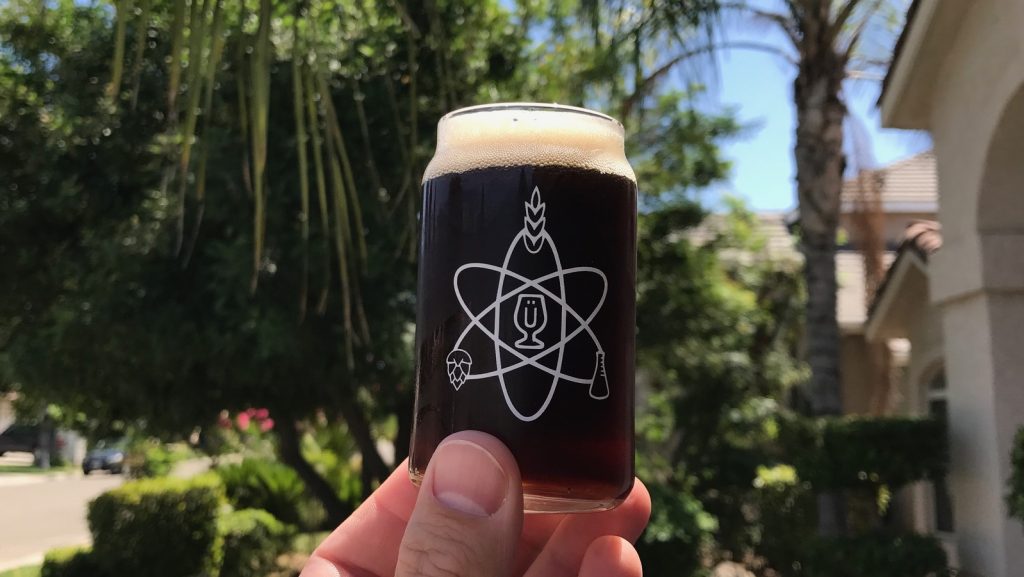











45 thoughts on “Short & Shoddy | Oatmeal Porter”
I’ve just tasted my Short & Shoddy Blond Ale (1h30 brewday) and it came out awesome. I can’t belive this craziness actually work! Thanks 🙂
Just . . . . wow. You may have finally convinced me to try this.
“then where is all the shitty beer coming from?” My theory, for what it’s worth is the base recipe. When I see 3 or 4 different base malts with the same number of specialty malts, then 5 different hops, I cringe. Ok that’s a bit exaggerated, but I think this type of chemistry experiment type recipe just muddies up the final beer.
I think you’re partially right. A lot of folks I taught to homebrew/homebrewed with went from basic recipes in Papazian and Palmer to Quadruple IPA with 20 hop additions and 10 grains, plus Brett! in about five brews, and their stuff was always terrible because they didn’t learn in an iterative or evolutionary way how to make what they wanted to make.
I think another likely culprit is sanitation. I’ve been practicing absolutely stupid sanitation since I started brewing 23 years ago (when I was 18!), and I’ve never had a bad batch. Not a single one. I had misses, where maybe the yeast didn’t fit with what I was going for so it tasted a little off, but it wasn’t “shitty”. My friends and I still drank all five gallons. Shitty beer is probably a combination of shitty recipes and shitty sanitation.
Now that I think about it, I might have had one batch about 6 years ago that started to develop a pellicle (I didn’t know what it was at the time), but I bottled it and my buddies and I drank it over the course of a weekend and there were no off flavors, so maybe any infection never got a chance to take hold.
Thank you for this experiment. With an old house, old car, old boat and beautiful wife, I don’t always have time for long brew-days. One method I use is a partial mash that starts the boil with extract at the while the grain is mashing, adding the mashed wort as a late addition. I am considering using short mash and boil for most of my batches going forward.
A guy in my homebrew club just won our APA competition with a beer he said he boiled for only 15 minutes. It was delicious.
I’ve been hearing stories like this a ton lately, so cool!
A question and an observation:
Question: Do you think that a full hour mash/bash sparge would have been worth the extra time to improve mash efficiency?
Observation: “Where is all the shitty beer coming from?” My guess: Shitty water. Water seems to be the last thing addressed by new brewers, and once mastered it almost seems hard to make bad beer, all other things being equal. My second guess: Poor-quality ingredients and/or poor recipe design.
*batch sparge
I think you’re saying batch sparge would have improved efficiency? If so, consider that batch sparging is nearly identical to full volume mashing regarding sugars transferred to the boil kettle – except that batch sparging might lower the efficiency # a bit. Mashing 100% of the grain in 100% of the water and then squeezing out the wort from the grain in the bag produces a fixed gravity wort and leaves about 7 oz trapped in the grain. That’s as close to transferring 100% of the sugars as you can get. Also consider that when batch sparging, diluted wort with sugar in it is usually left in the mash tun.
I personally don’t get home brewers obsession with chasing efficiency. How much is your time worth? If you feel that an extra 40 min mash is worthy of your time versus a couple of bucks in grain, then it is worth it. If your time is worth more then that, then it isn’t worth it. The beer will be the same in the end.
Losses loom larger than gains (for just about anything.) This is one of the most extensively documented heuristics in experimental psychology. In trade-offs people almost always see the losses as more significant than the gains. Hence, if you’re getting 80% efficiency in 1 hour mashing, and someone says “Why not 50% in 15 minutes?” the 30% attracts much more weight in decision making than the 45 minutes. If we’d all started out “short and shoddy”, we’d see the 45 minutes as more important.
THIS! Bad water, bad ingredients, bad recipe design.
I’ll also add widely fluctuating fermentation temp (that’s one that I still think needs explored). Most homebrewers dont control that variable.
The water idea is an interesting one, but 90% of the people I know brew with more or less the same tap water. Some of the beer is good, some is not. So it’s not just the water.
Inspired by your earlier XBMTs I have done 2 ‘short n shoddy’ patersbiers and both were fantastic. As far as the ‘shitty beer’ question, I’d agree with others (as a conjecture) that ingredients, poor recipes, and bad sanitation are likely culprits as well as crappy storage/bottle conditioning management (time and temp).
Where is the love for patersbier? The best beer I ever made, and probably the best beer I’ve ever consumed, was a patersbier I made with some left-over ingredients, just to see what this style tastes like. Dang, what an awesome brew.
Best short & shoddy yet! I’m a fan of Short & TIDY. If you plan this stuff carefully you can do short and tidy and you reduce the chances of other mistakes from winging it.
Awesome!
Nice, and another buster on the board. Someday I hope to convince you that tossing wort not squeezed from the grain, no matter the target volume – that is the same gravity – is silly.
I love the series “short & shoddy”. I also have the same problems of time constraint, but, at the same time, love to brew.
In respect of “all that shit beers”, I think that experience also count to make great/good beers.
I love that you guys are crushing what are thought to be ‘standard practices’. Keep on pushing that envelope! I find it tremendously helpful in narrowing down what could possibly be going wrong/right in my own brewing.
next focus for me: re-evaluate sani practices, tackle brewing water chemistry, better bottling practice to prevent O2. Thanks guys!
But don’t forget that “you can’t tell the difference between A and B” and “you can’t tell the difference between B and C” doesn’t imply “you can’t tell the difference between A and C.”
Short and shoddy is the only way I do it with the limited time I have these days.
I think its more important to get a healthy yeast cell count (starter)
and keep temps in control (high or low doesn’t matter, but steady).
If the enzymes convert most of the grain to sugary wort in 20-30 mins then why wait an hour? Also boiling, as long as you have a hot break why does it matter how long it boils…. It doesn’t seem to matter in my recent experience.
The last bad beer I made was a Saison that I didn’t use a starter for, and jacked up the temp to the 80s too early in the process.
Short & Shoddy brewing allows me to still maintain this awesome hobby with small kids and a family. Thanks guys for the inspiration.
Great article! How readily available is that chocolate malt in the US? If not, recommend a near match?
Thanks! I’m trying to get people to request Gladfield Malt from anywhere they purchase malt, as it’s currently not available in the US. I’d probably go with something like Briess Chocolate malt as a sub.
I brewed 5 gallons of a S/S RIPA last year to take camping. I believe it was 30/30 min mash and boil respectively. I also kegged, force carbed and was drinking it 6 days post pitching my yeast (US-05). It was so damn good! I haven’t re-visited for whatever reason, but I can attest that you can make great beer with this method. Thanks for giving me the courage to veer from the norm.
Great article!
Are you using the Rager formula for IBU calculation?
Thanks!
Tinseth
I was asking cause with Tinseth, the single addition of 50g of Magnum (11.20%) at 20min give me around 39 IBUs in BeerSmith. I’ll check my numbers.
Thanks!
Hi, just finishing up the final stages of fermenting this recipe. Managed an efficiency of roughly 70%, but fermentation seems to have stalled at about 65% attenuation. Have you had any troubles with underattunuation in short and shoddy beers?
I haven’t. What’s your OG and current SG?
My OG is 1060 and current SG is 1022. Measured SG at 1022 about five days ago, agitated the wort, and it is still sitting at 1022, so I think something must have gone wrong. Pitched two packages of US-05 too, so it shouldn’t be any lack of cells. Fermenting a volume of 13 liters.
I overshot the mash pH, using lactic acid, and it ended up at 5. Do you think it can have anything to do with that? Btw, any reason for shooting for a mash pH target of 5.25, instead of in the range of 5.4-5.6?
Interestingly, my 1.052 to 1.014 beer ended with the same ABV as your 1.060 to 1.022 beer, despite a 10% difference in attenuation.
I’m highly doubtful this has anything to do with mash pH, as I’ve only seen such high FG when making high OG beers or mashing warm. To be honest, I’d call it good package!
Really anxious to try this recipe and process! One thing I noticed is that when I plugged the items into BeerSmith, my numbers are pretty off from yours. For example: OG: 1.066, IBUs: 50.3, SRM: 25.9 Could this be because BeerSmith isn’t calculating the “short method” with my equipment accurately? I’m mainly only concerned with the high IBUs for the style, I can live with everything else. keep up the great work!
There are a number of things it could be. Did you change your boil time to 20 minutes and adjust for that with your hop addition?
Apparently, I accidentally added the FWH addition twice. There’s the problem! All is good now!
Used this exact recipe/process last night and ended up with the same OG. Looking forward to sampling the end result. This could be a game changer for sure!
I just made this. I can’t believe how delicious this beer is. It’s incredibly smooth with just the right amount of roasty goodness. I did end up with a higher efficiency (1.060), so I’ll have to account for my personal shoddiness in the future. Thanks for the great beer!
Given the results of these “Short and Shoddy” brews and the amount of non-significant results from your experiments, if you were to set out to make a “bad beer” intentionally, what would you do?
Even in your experiments that come back with significant differences, you never mention anyone saying the beer tastes bad. Usually just different. But I have had some BAD beers before! I’ve brewed a few myself…
This is a great question for a Brü & A episode, would you mind emailing it to me with your full name and location?
My short answer: I wouldn’t clean or sanitize any of my cold side gear that comes into contact with the wort and I’d way under pitch with really old yeast.
Sure, sent!
My LHBS doesn’t carry Imperial yeast. They do carry White Labs. Any suggestions on a substitute?
WLP002
This may be a stupid question, but can this recipe be used as it is for a normal brew day?
Fo sho.